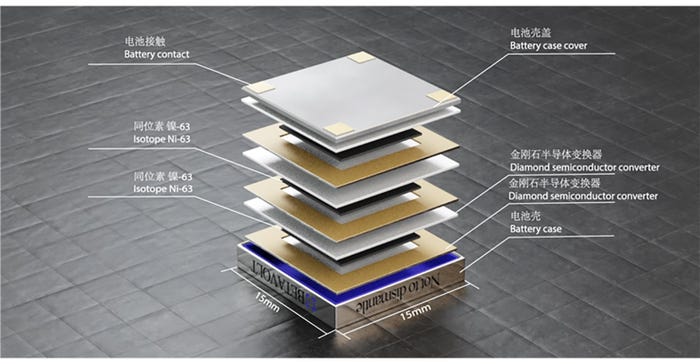Betavolt Battery: 50-Year Charge, Cellphone Powered for Decades
Discover the groundbreaking Betavolt atomic battery, redefining energy with a 50-year charge cycle.

For decades, scientists have extensively explored the extensive capabilities of nuclear power. Yet, the challenge lies in harnessing this powerful energy and finding a secure means to store it within confined spaces. Certain radioactive isotopes' volatility, toxicity, and impracticality have deterred their use in direct conversion power sources. However, in the face of these challenges, a promising solution emerges—stable isotopes that hold the potential to fuel power battery-operated devices for prolonged durations. A company at the forefront of developing nuclear batteries has announced that it has successfully created a miniature atomic energy battery.
Betavolt is a Chinese company claiming that the new atomic energy battery can generate electricity stably and autonomously for 50 years without charging or maintenance. Betavolt atomic energy batteries address the demand for enduring power across diverse applications for civilian use, including AI equipment, medical devices, MEMS systems, advanced sensors, small drones, and micro-robots.
What is an atomic battery?
According to City Labs, “A nuclear battery is any device that harnesses energy from radioactive element isotope decay to generate electricity. Nuclear battery, atomic battery, and radioisotope generator are interchangeable terms that indicate how the power source creates a current. Radioisotope generators capitalize on the decay of radioactive alpha, beta, and gamma particles to provide a constant energy source. As these particles are emitted, they stir electrons in the battery system to create a current.”
Betavolt believes that only thermonuclear batteries find application in aerospace. However, these batteries suffer from considerable size and weight, elevated internal temperatures, and high costs, rendering them impractical for civilian use.
Betavolt’s technology
Betavolt has developed a different technological approach, generating electric currents through the semiconductor transition of beta particles (electrons) emitted by the radioactive source nickel-63. To do this, Betavolt's team of scientists developed a unique single-crystal diamond semiconductor—ultra-wide band gap (UWBG) semiconductor—that is just 10µ thick, placing a 2µ thick nickel-63 sheet between two diamond semiconductor converters. The decay energy of the radioactive source is converted into an electrical current, forming an independent unit. These nuclear batteries are modular and can be composed of dozens or hundreds of independent unit modules and can be used in series and parallel, so battery products of different sizes and capacities can be manufactured.

The BV100 is a modular battery. A module is composed of at least 2 converters and 1 layer of nickel-63. Courtesy of Betavolt.
Zhang Wei, chairman and CEO of Betavolt, stated, “The first product the company will launch is BV100, which is the world's first nuclear battery to be mass-produced.” In 2025, the company aims to release a 1-watt power battery. Pending policy approval, atomic energy batteries could eliminate the need even to charge mobile phones and enable drones, currently limited to 15 minutes of flight, to operate continuously.
According to Betavolt, “The atomic energy battery is a physical battery, not an electrochemical battery. Its energy density is more than ten times that of ternary lithium batteries. It can store 3,300 MW hours in a 1-gram battery. It will not catch fire or explode in response to acupuncture and gunshots. Because it generates electricity automatically for 50 years, there is no concept of the number of cycles of an electrochemical battery (2000 charges and discharges).” He continued, “The core of Betavolt atomic energy battery is the fourth generation diamond semiconductor, which is the ultimate semiconductor material well known in the industry and another high ground in the global semiconductor field technology competition.”

The atomic energy battery mainly uses nickel-63 as the energy source and diamond semiconductor as the energy converter. Courtesy of Betavolt.
The company claims absolute safety without external radiation, making it suitable for medical devices like pacemakers, artificial hearts, and cochlear implants. Betavolt details the safety of atomic energy batteries, which undergo a decay period where the radioactive nickel-63 isotope transforms into a stable, non-radioactive copper isotope. This eliminates environmental threats or pollution.
The remarkable claim of a 50-year charge cycle opens doors to possibilities previously deemed unreachable. Imagine a world where constantly charging your cell phone becomes a thing of the past. Betavolt's innovation has the potential to revolutionize how we approach sustainability and longevity in electronic devices.
About the Author(s)
You May Also Like





